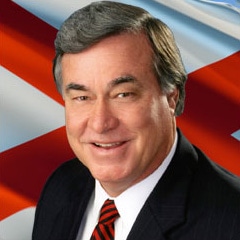When Bob Riley took office in January of 2003 he had just survived one of the most bruising gubernatorial elections in history. His razor thin margin of victory over Don Siegelman hardly gave him a mandate for major accomplishment in state government. He and Siegelman had so pulverized each other in campaign ads that most voters wondered why both were not in jail. Ironically a cloud was brewing over Siegelman and he indeed would be heading for jail.
As businessman Bob Riley took the reigns of state government, his only political experience had been his previous six years of service in congress. He had no experience in state government and both branches of the legislature were overwhelmingly Democratic. Although partisan acrimony was not as pronounced as it was in Washington, partisanship had arrived in Montgomery and neither the Democratic legislature nor the powers that controlled the legislature wanted a Republican governor to succeed.
For reasons that nobody can figure out Riley immediately set out to commit political suicide. Both the General Fund and Education Fund were in the red and facing a crisis. Even though the general public did not believe this perennial cry of wolf, Riley saw the figures and bought into the crisis mentality. However, Riley, who was a Reagan small government fiscal conservative, went in the opposite direction than his idol Reagan would have gone. Instead of asking for massive cuts in government spending Riley offered the biggest tax increase in state history, $1.2 billion to be exact.
The most unbelievable approach was that the plan Riley offered and enacted by an eager Democratic legislature placed the entire tax burden on Republicans. The most onerous part of the tax burden was directed at the special interests who had backed Riley the most in his race for governor. It was as though he took a rifle and aimed the tax at his supporters starting with those who had most loyally backed him. It was a blunder of monumental proportions. Voters defeated his proposal by a 3 to 1 margin.
At the end of Riley’s first year in office he appeared to be a lame duck. Most pundits wrote his chances for reelection off as slim to none. Siegelman, who had never stopped running, was exuberant. Fellow Republicans were also eyeing the 2006 Governor’s race to succeed Riley. The governor’s office had been a musical chair since 1994. No incumbent governor had won reelection in the last three races and this one seemed to be on course to follow that trend.
The most logical aspirant to take out Riley was Lt. Gov. Lucy Baxley who had served two successful terms as state treasurer and had been elected the first female lieutenant governor in state history. She received the most votes of any statewide candidate in her 2002 race for the state’s second highest office and had great name identification. She was simply known as “Lucy.”
Lucy sat back and quietly watched Riley self-destruct. She took no position on the tax debacle or anything else. She did not have to because there is no power in the lt. governor’s office.
Riley, to his credit, took his setback in stride with great resilience. He quickly recovered and his next three years were very Republican. He espoused less government and lower taxes. He cut ribbons and smiled and handled crisis like hurricanes with aplomb and confidence. Riley looked gubernatorial. In fact, his handling of Hurricane Katrina in August of 2005 marked a turning point in his political recovery. At that point, his positives shot up dramatically and continued to skyrocket.
Ironically, Lucy had to make a decision to run at this same time. The polling numbers she saw in July of 2005 revealed that she could beat Riley. She pulled the trigger around the same time as Hurricane Katrina. However, Riley turned the tide about a month later and never looked back. His numbers escalated. He trounced former Chief Justice Roy Moore 70% to 30% in the GOP primary. Lucy defeated Don Siegelman, who was under indictment and was actually convicted during the primary of ethics violations. Lucy’s margin over a hapless Siegelman of 60% to 40% portended that she was not as strong as once thought.
Once the dust settled after the June primaries, all indications from polling and otherwise showed that Riley would be tough to beat in the fall. The first polls showed him with a double digit lead over Lucy. As the summer ended and the fall campaign began in September, Riley’s lead in the polls had grown to 20 points. It went as high as 25 points as late as mid October.
Riley’s insurmountable lead in the polls transpired into an avalanche of campaign fundraising. He outspent the underdog Lucy Baxley by a 4 to 1 margin. Riley ran an aggressive, well managed, 21st century campaign spearheaded by some of the best and most expensive political consultants in America. His positive, happy, confident personality and charisma were captured and reflected in his ads. It resulted in a landslide victory over Democrat Lucy Baxley.
See you next week.

Steve Flowers
Alabama’s premier columnist and commentator, Steve has analyzed Alabama politics for national television audiences on CBS, PBS, ABC and the British Broadcasting Network. Steve has been an up close participant and observer of the Alabama political scene for more than 50 years and is generally considered the ultimate authority on Alabama politics and Alabama political history.